Did Governments Follow the Biological Science or the Political Science in School Closures?
School Closures – Part 2 – Over One Billion Children and Young Adults Have Been Negatively Affected Emotionally, Mentally and Physically from School Closures!

The British Columbia Center for Disease Control (BCCDC) issued a full report in September 2020 on the impact of school closures on children and found para “that
1) children comprise a small proportion of theorectical diagnosed COVID-19 cases, have less severe illness, and mortality is rare
2) children do not appear to be a major source of SARS-CoV-2 transmission in households or schools, a finding which has been consistent globally
3) there are important differences between how influenza symptoms and SARS-CoV-2 symptoms are theoretically transmitted. School closures may be less effective as a prevention measure for COVID-19
4) school closures can have severe and unintended consequences for children and youth
5) school closures contribute to greater family stress, especially for female caregivers, while families balance child care and home learning with employment demands
6) family violence may be on the rise during the COVID pandemic, while the closure of schools and childcare centers may create a gap in the safety net for children who are at risk of abuse and neglect.”
A recent 2021 study, “Impact of the COVID-19 Pandemic on Early Child Cognitive Development: Initial Findings in a Longitudinal Observational Study of Child Health,” captures the essence and catastrophe of a lockdown society and the hollowing out of our children by looking at how children learn (3 months to 3 years old) and finding across all measures that “children born during the pandemic have significantly reduced verbal, motor, and overall cognitive performance compared to children born pre-pandemic.”
Researchers also reported that “males and children in lower socioeconomic families have been most affected. Results highlight that even in the absence of direct SARS-CoV-2 infection and COVID-19 illness, the environmental changes associated with the COVID-19 pandemic is significantly and negatively affecting infant and child development.”
What follows below is the current totality of the body of scientific evidence (available comparative studies and high-level pieces of evidence, reporting, and discussion) for school closures causing physical, mental and emotional injuries to children and young adults.
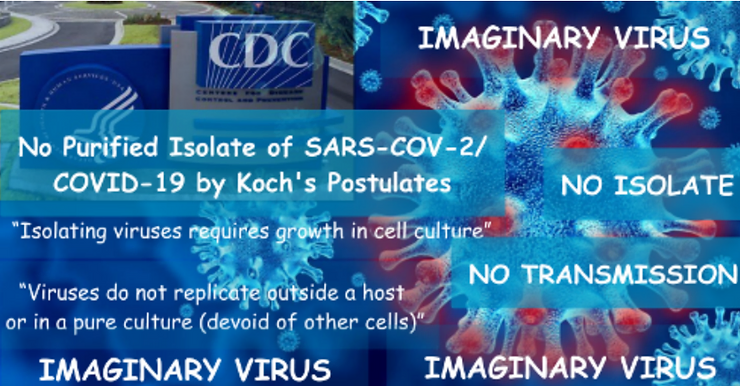
What YOU Will Learn from the following biological published science NOT the political science is this important fact – There is NO Conclusive Evidence from anyone, anywhere in the world supporting the closures of schools around the World was effective in reducing the risks of infectivity or transmission of a non-existent, unproven, theoretical, so-called SARS CoVid – 19 virus!
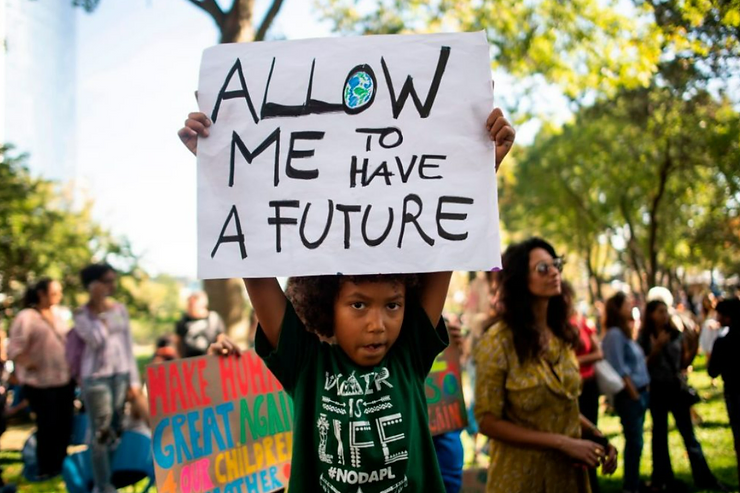
The Harmful Effects of School Closures on the Physical and Mental Health of Children and Adolescents Published in the Following 84 Peer-Reviewed Scientific Journal Articles!
Please Read, Ponder, Care and then Share the TRUTH With Everyone YOU Love and Care About!
Say NO to School Closures Now and in the FUTURE!
1) Suffering in silence: How COVID-19 school closures inhibit the reporting of child maltreatment, Baron, 2020
“While one would expect the financial, mental, and physical stress due to COVID-19 to result in additional child maltreatment cases, we find that the actual number of reported allegations was approximately 15,000 lower (27%) than expected for these two months. We leverage a detailed dataset of school district staffing and spending to show that the observed decline in allegations was largely driven by school closures.”
2) Association of routine school closures with child maltreatment reporting and substantiation in the United States; 2010-2017, Puls, 2021
“Results suggest that the detection of child maltreatment may be diminished during periods of routine school closure.”
3) Reporting of child maltreatment during the SARS-CoV-2 pandemic in New York City from March to May 2020, Rapoport, 2021
“Precipitous drops in child maltreatment reporting and child welfare interventions coincided with social distancing policies designed to mitigate COVID-19 transmission.”
“The COVID-19 pandemic has led to a precipitous drop in CAN investigations where almost 200,000 children are estimated to have been missed for prevention services and CAN in a 10-month period.”
5) Effect of school closures on mortality from coronavirus disease 2019: old and new predictions, Rice, 2020
“We therefore conclude that the somewhat counterintuitive results that school closures lead to more deaths are a consequence of the addition of some interventions that suppress the first wave and failure to prioritise protection of the most vulnerable people. When the interventions are lifted, there is still a large population who are susceptible and a substantial number of people who are infected. This then leads to a second wave of infections that can result in more deaths, but later. Further lockdowns would lead to a repeating series of waves of infection unless herd immunity is achieved by vaccination, which is not considered in the model. A similar result is obtained in some of the scenarios involving general social distancing. For example, adding general social distancing to case isolation and household quarantine was also strongly associated with suppression of the infection during the intervention period, but then a second wave occurs that actually concerns a higher peak demand for ICU beds than for the equivalent scenario without general social distancing.”
“This extreme measure provoked a disruption of the educational system involving hundreds of million children worldwide. The return of children to school has been variable and is still an unresolved and contentious issue. Importantly the process has not been directly correlated to the severity of the pandemic s impact and has fueled the widening of disparities, disproportionately affecting the most vulnerable populations. Available evidence shows SC added little benefit to COVID-19 control whereas the harms related to SC severely affected children and adolescents. This unresolved issue has put children and young people at high risk of social, economic and health-related harm for years to come, triggering severe consequences during their lifespan.”
7) The Impact of COVID-19 School Closure on Child and Adolescent Health: A Rapid Systematic Review, Chaabane, 2021
“COVID-19-related school closure was associated with a significant decline in the number of hospital admissions and pediatric emergency department visits. However, a number of children and adolescents lost access to school-based healthcare services, special services for children with disabilities, and nutrition programs. A greater risk of widening educational disparities due to lack of support and resources for remote learning were also reported among poorer families and children with disabilities. School closure also contributed to increased anxiety and loneliness in young people and child stress, sadness, frustration, indiscipline, and hyperactivity. The longer the duration of school closure and reduction of daily physical activity, the higher was the predicted increase of Body Mass Index and childhood obesity prevalence.”
“Reported on the effects that social isolation and loneliness may have on children and adolescents during the global 2019 novel coronavirus disease (COVID-19) pandemic, with their findings suggesting associations between social anxiety and loneliness/social isolation.”
9) Parental job loss and infant health, Lindo, 2011
“Husbands’ job losses have significant negative effects on infant health. They reduce birth weights by approximately four and a half percent.”
10) Closing schools is not evidence based and harms children, Lewis, 2021
“For some children education is their only way out of poverty; for others school offers a safe haven away from a dangerous or chaotic home life. Learning loss, reduced social interaction, isolation, reduced physical activity, increased mental health problems, and potential for increased abuse, exploitation, and neglect have all been associated with school closures. Reduced future income6 and life expectancy are associated with less education. Children with special educational needs or who are already disadvantaged are at increased risk of harm.”
11) Impacts of school closures on physical and mental health of children and young people: a systematic review, Viner, 2021
“School closures as part of broader social distancing measures are associated with considerable harms to CYP health and wellbeing. Available data are short-term and longer-term harms are likely to be magnified by further school closures. Data are urgently needed on longer-term impacts using strong research designs, particularly amongst vulnerable groups. These findings are important for policy-makers seeking to balance the risks of transmission through school-aged children with the harms of closing schools.”
12) School Closure: A Careful Review of the Evidence, Alexander, 2020
“Based on the existing reviewed evidence, the predominant finding is that children (particularly young children) are at very low risk of acquiring SARS-CoV-2 infection, and if they do become infected, are at very low risk of spreading it among themselves or to other children in the school setting, of spreading it to their teachers, or of spreading it to other adults or to their parents, or of taking it into the home setting; children typically become infected from the home setting/clusters and adults are typically the index case; children are at very low risk of severe illness or death from COVID-19 disease except in very rare circumstances; children do not drive SARS-CoV-2/COVID-19 as they do seasonal influenza; an age gradient as to susceptibility and transmission capacity exists whereby older children should not be treated the same as younger children in terms of ability to transmit e.g. a 6 year-old versus a 17 year-old (as such, public health measures would be different in an elementary school versus a high/secondary school); ‘very low risk’ can also be considered ‘very rare’ (not zero risk, but negligible, very rare); we argue that masking and social distancing for young children is unsound policy and not needed and if social distancing is to be used, that 3-feet is suitable over 6-feet and will address the space limitations in schools; we argue that we are well past the point where we must replace hysteria and fear with knowledge and fact. The schools must be immediately re-opened for in-person instruction as there is no reason to do otherwise.”
13) Children, school and COVID-19, RIVM, 2021
“If we look at all hospital admissions reported by the NICE Foundation between 1 January and 16 November 2021, 0.7% were younger than 4 years old. 0.1% were aged 4-11 years and 0.2% were aged 12-17 years. The vast majority (99.0%) of all people admitted to hospital with COVID-19 were aged 18 years or older.”
14) FEW CARRIERS, FEW TRANSMITTERS”: A STUDY CONFIRMS THE MINIMAL ROLE OF CHILDREN IN THE COVID-19 EPIDEMIC, Vincendon, 2020
“Children are few carriers, few transmitters, and when they are contaminated, it is almost always adults in the family who have contaminated them.”
15) Transmission of SARS-CoV-2 in children aged 0 to 19 years in childcare facilities and schools after their reopening in May 2020, Baden-Württemberg, Germany, Ehrhardt, 2020
“Investigated data from severe acute respiratory syndrome coronavirus 2 (SARS-CoV-2) infected 0-19 year old, who attended schools/childcare facilities, to assess their role in SARS-CoV-2 transmission after these establishments’ reopening in May 2020 in Baden-Württemberg, Germany. Child-to-child transmission in schools/childcare facilities appeared very uncommon.”
16) Australian Health Protection Principal Committee (AHPPC) coronavirus (COVID-19) statements on 24 April 2020, Australian government, 2020
“AHPPC continues to note that there is very limited evidence of transmission between children in the school environment; population screening overseas has shown very low incidence of positive cases in school-aged children. In Australia, 2.4 per cent of confirmed cases have been in children aged between 5 and 18 years of age (as at 6am, 22 April 2020). AHPPC believes that adults in the school environment should practice room density measures (such as in staff rooms) given the greater risk of transmission between adults.”
17) AN EVIDENCE SUMMARY OF PAEDIATRIC COVID-19 LITERATURE, Boast, 2021
“Critical illness is very rare (~1%). In data from China, the USA and Europe, there is a “U shaped” risk gradient, with infants and older adolescents appear most likely to be hospitalized and to suffer from more severe disease. Deaths in children remain extremely rare from COVID-19, with only 4 deaths in the UK as of May 2020 in children <15 years, all in children with serious comorbidities.”
18) Transmission dynamics of SARS-CoV-2 within families with children in Greece: A study of 23 clusters, Maltezou, 2020
“While children become infected by SARS-CoV-2, they do not appear to transmit infection to others.”
19) No evidence of secondary transmission of COVID-19 from children attending school in Ireland, 2020, Heavey, 2020
“Children are thought to be vectors for transmission of many respiratory diseases including influenza. It was assumed that this would be true for COVID-19 also. To date however, evidence of widespread paediatric transmission has failed to emerge. School closures create childcare issues for parents. This has an impact on the workforce, including the healthcare workforce. There are also concerns about the impact of school closures on children’s mental and physical health… examination of all Irish paediatric cases of COVID-19 attending school during the pre-symptomatic and symptomatic periods of infection (n = 3) identified no cases of onward transmission to other children or adults within the school and a variety of other settings. These included music lessons (woodwind instruments) and choir practice, both of which are high-risk activities for transmission. Furthermore, no onward transmission from the three identified adult cases to children was identified.”
20) COVID-19, school closures, and child poverty: a social crisis in the making, Van Lancker, 2020
“The UN Educational, Scientific and Cultural Organization estimates that 138 countries have closed schools nationwide, and several other countries have implemented regional or local closures. These school closures are affecting the education of 80% of children worldwide. Although scientific debate is ongoing with regard to the effectiveness of school closures on virus transmission, the fact that schools are closed for a long period of time could have detrimental social and health consequences for children living in poverty, and are likely to exacerbate existing inequalities.”
21) Impact of school closures for COVID-19 on the US health-care workforce and net mortality: a modelling study, Bayham, 2020
“School closures come with many trade-offs, and can create unintended child-care obligations. Our results suggest that the potential contagion prevention from school closures needs to be carefully weighted with the potential loss of health-care workers from the standpoint of reducing cumulative mortality due to COVID-19, in the absence of mitigating measures.”
22) The Truth About Kids, School, and COVID-19, Thompson/The Atlantic, 2021
“The CDC’s judgment comes at a particularly fraught moment in the debate about kids, schools, and COVID-19. Parents are exhausted. Student suicides are surging. Teachers’ unions are facing national opprobrium for their reluctance to return to in-person instruction. And schools are already making noise about staying closed until 2022… Research from around the world has, since the beginning of the pandemic, indicated that people under 18, and especially younger kids, are less susceptible to infection, less likely to experience severe symptoms, and far less likely to be hospitalized or die…in May 2020, a small Irish study of young students and education workers with COVID-19 interviewed more than 1,000 contacts and found “no case of onward transmission” to any children or adults. In June 2020, a Singapore study of three COVID-19 clusters found that “children are not the primary drivers” of outbreaks and that “the risk of SARS-CoV-2 transmission among children in schools, especially preschools, is likely to be low.”
23) Feared coronavirus outbreaks in schools yet to arrive, early data shows, Meckler/The Washington Post, 2020
“This early evidence, experts say, suggests that opening schools may not be as risky as many have feared and could guide administrators as they chart the rest of what is already an unprecedented school year. Everyone had a fear there would be explosive outbreaks of transmission in the schools. In colleges, there have been. We have to say that, to date, we have not seen those in the younger kids, and that is a really important observation.”
24) Three studies highlight low COVID risk of in-person school, CIDRAP, 2021
“A trio of new studies demonstrate low risk of COVID-19 infection and spread in schools, including limited in-school COVID-19 transmission in North Carolina, few cases of the coronavirus-associated multisystem inflammatory syndrome in children (MIS-C) in Swedish schools, and minimal spread of the virus from primary school students in Norway.”
25) Incidence and Secondary Transmission of SARS-CoV-2 Infections in Schools, Zimmerman, 2021
“In the first 9 weeks of in-person instruction in North Carolina schools, we found extremely limited within-school secondary transmission of SARS-CoV-2, as determined by contact tracing.”
26) Open Schools, Covid-19, and Child and Teacher Morbidity in Sweden, Ludvigsson, 2020
“Of the 1,951,905 children aged 1 to 16 years in Sweden as of Dec 31, 2019, 65 died in the pre-pandemic period of November 2019 to February 2020, compared with 69 in the pandemic period of March through June 2020. None of the deaths were caused by COVID-19. Fifteen children diagnosed as having COVID-19, including seven with MIS-C, were admitted to an intensive care unit (ICU) from March to June 2020 (0.77 per 100,000 children in this age-group). Four children required mechanical ventilation. Four children were 1 to 6 years old (0.54 per 100,000), and 11 were 7 to 16 (0.90 per 100,000). Four of the children had an underlying illness: 2 with cancer, 1 with chronic kidney disease, and 1 with a hematologic disease). Of the country’s 103,596 preschool teachers and 20 schoolteachers, fewer than 10 were admitted to an ICU by Jun 30, 2020 (an equivalent of 19 per 100,000).”
27) Minimal transmission of SARS-CoV-2 from paediatric COVID-19 cases in primary schools, Norway, August to November 2020, Brandal, 2021
“This prospective study shows that transmission of SARS-CoV-2 from children under 14 years of age was minimal in primary schools in Oslo and Viken, the two Norwegian counties with the highest COVID-19 incidence and in which 35% of the Norwegian population resides. In a period of low to medium community transmission (a 14-day incidence of COVID-19 of < 150 cases per 100,000 inhabitants), when symptomatic children were asked to stay home from school, there were < 1% SARS-CoV-2–positive test results among child contacts and < 2% positive results in adult contacts in 13 contract tracings in Norwegian primary schools. In addition, self-collection of saliva for SARS-CoV-2 detection was efficient and sensitive (85% (11/13); 95% confidence interval: 55–98)…use of face masks is not recommended in schools in Norway. We found that with the IPC measures implemented there is low to no transmission from SARS-CoV-2–infected children in schools.”
28) Children are unlikely to be the main drivers of the COVID-19 pandemic – A systematic review, Ludvigsson, 2020
“Identified 700 scientific papers and letters and 47 full texts were studied in detail. Children accounted for a small fraction of COVID-19 cases and mostly had social contacts with peers or parents, rather than older people at risk of severe disease…Children are unlikely to be the main drivers of the pandemic. Opening up schools and kindergartens is unlikely to impact COVID-19 mortality rates in older people.”
29) Science Brief: Transmission of SARS-CoV-2 in K-12 Schools and Early Care and Education Programs – Updated, CDC, 2021
“Findings from several studies suggest that SARS-CoV-2 transmission among students is relatively rare, particularly when prevention strategies are in place…several studies have also concluded that students are not the primary sources of exposure to SARS-CoV-2 among adults in school setting.”
30) Children under 10 less likely to drive COVID-19 outbreaks, research review says, Dobbins/McMaster, 2020
“The bottom line thus far is that children under 10 years of age are unlikely to drive outbreaks of COVID-19 in daycares and schools and that, to date, adults were much more likely to be the transmitter of infection than children.”
31) Role of children in the transmission of the COVID-19 pandemic: a rapid scoping review, Rajmil, 2020
“Children are not transmitters to a greater extent than adults. There is a need to improve the validity of epidemiological surveillance to solve current uncertainties, and to take into account social determinants and child health inequalities during and after the current pandemic.
32) COVID-19 in schools – the experience in NSW, NCIRS, 2020
“SARS-CoV-2 transmission in children in schools appears considerably less than seen for other respiratory viruses, such as influenza. In contrast to influenza, data from both virus and antibody testing to date suggest that children are not the primary drivers of COVID-19 spread in schools or in the community. This is consistent with data from international studies showing low rates of disease in children and suggesting limited spread among children and from children to adults.”
33) Spread of SARS-CoV-2 in the Icelandic Population, Gudbjartsson, 2020
“In a population-based study in Iceland, children under 10 years of age and females had a lower incidence of SARS-CoV-2 infection than adolescents or adults and males.”
34) Case-Fatality Rate and Characteristics of Patients Dying in Relation to COVID-19 in Italy, Onder, 2020
Infected children and females were less likely to have severe disease.
35) BC Center for Disease Control, BC Children’s hospital, 2020
“BC families reported impaired learning, increased child stress, and decreased connection during COVID-19 school closures, while global data show increased loneliness and declining mental health, including anxiety and depression… Provincial child protection reports have also declined significantly despite reported increased domestic violence globally. This suggests decreased detection of child neglect and abuse without reporting from schools… The impact of school closures is likely to be experienced disproportionately by families subject to social inequities, and those with children with health conditions or special learning needs. Interrupted access to school-based resources, connections, and support compounds the broader societal impact of the pandemic. In particular, there are likely to be greater effects on single parent families, families in poverty, working mothers, and those with unstable employment and housing.”
36) Transmission of SARS-CoV-2 in Australian educational settings: a prospective cohort study, Macartney, 2020
“SARS-CoV-2 transmission rates were low in NSW educational settings during the first COVID-19 epidemic wave, consistent with mild infrequent disease in the 1·8 million child population.”
37) COVID-19 Cases and Transmission in 17 K–12 Schools — Wood County, Wisconsin, August 31–November 29, 2020, CDC/Falk, 2021
“In a setting of widespread community SARS-CoV-2 transmission, few instances of in-school transmission were identified among students and staff members, with limited spread among children within their cohorts and no documented transmission to or from staff members.”
38) COVID-19 in children and the role of school settings in transmission – second update, ECDC, 2021
“Children aged between 1-18 years have much lower rates of hospitalisation, severe disease requiring intensive hospital care, and death than all other age groups, according to surveillance data…the decision to close schools to control the COVID-19 pandemic should be used as a last resort. The negative physical, mental and educational impacts of proactive school closures on children, as well as the economic impact on society more broadly, would likely outweigh the benefits.”“Investigations of cases identified in school settings suggest that child to child transmission in schools is uncommon and not the primary cause of SARS-CoV-2 infection in children whose onset of infection coincides with the period during which they are attending school, particularly in preschools and primary school.”
39) COVID-19 in children and young people, Snape, 2020
“The near-global closure of schools in response to the pandemic reflected the reasonable expectation from previous respiratory virus outbreaks that children would be a key component of the transmission chain. However, emerging evidence suggests that this is most likely not the case. A minority of children experience a postinfectious inflammatory syndrome, the pathology and long-term outcomes of which are poorly understood. However, relative to their risk of contracting disease, children and adolescents have been disproportionately affected by lockdown measures, and advocates of child health need to ensure that children’s rights to health and social care, mental health support, and education are protected throughout subsequent pandemic waves…There are many other areas of potential indirect harm to children, including an increase in home injuries (accidental and nonaccidental) when children have been less visible to social protection systems because of lockdowns. In Italy, hospitalizations for accidents at home increased markedly during the COVID-19 lockdown and potentially posed a higher threat to children’s health than COVID-19. UK pediatricians report that delay in presentations to hospital or disrupted services contributed to the deaths of equal numbers of children that were reported to have died with SARS-CoV-2 infection. Many countries are seeing evidence that mental health in young people has been adversely affected by school closures and lockdowns. For example, preliminary evidence suggests that deaths by suicide of young people under 18 years old increased during lockdown in England.”
“Children and young people have less severe acute covid-19 than adults.”
41) The Dangers of Keeping the Schools Closed, Yang, 2020
“The data from a range of countries shows that children rarely, and in many countries never, have died from this infection. Children appear to get infected at a much lower rate than those who are older… there is no evidence that children are important in transmitting the disease…What we know about social distancing policies is based largely on models of influenza, where children are a vulnerable group. However, preliminary data on COVID-19 suggests that children are a small fraction of cases and may be less vulnerable than older adults.”
42) SARS-CoV-2 Infection in Children, Lu, 2020
“In contrast with infected adults, most infected children appear to have a milder clinical course. Asymptomatic infections were not uncommon.”
43) Characteristics of and Important Lessons From the Coronavirus Disease 2019 (COVID-19) Outbreak in China: Summary of a Report of 72 314 Cases From the Chinese Center for Disease Control and Prevention, Wu, 2020 – Less than 1% of the cases were in children younger than 10 years of age.
44) Risk for COVID-19 Infection, CDC, 2021
A CDC report on hospitalization and death in children, found that when compared to persons 18 to 29 years old, children 0 to 4 years had a 4x lower rate of hospitalization and a 9x lower rate of death. Children 5 to 17 years old had a 9x lower rate of hospitalization and a 16x lower rate of death.
45) Children are unlikely to have been the primary source of household SARS-CoV-2 infections, Zhu, 2020
“Whilst SARS-CoV-2 can cause mild disease in children, the data available to date suggests that children have not played a substantive role in the intra-household transmission of SARS-CoV-2.”
46) Characteristics of Household Transmission of COVID-19, Li, 2020
“The secondary attack rate to children was 4% compared with 17.1% for adults.”
47) Are The Risks Of Reopening Schools Exaggerated?, Kamenetz/NPR, 2020
“Despite widespread concerns, two new international studies show no consistent relationship between in-person K-12 schooling and the spread of the coronavirus. And a third study from the United States shows no elevated risk to childcare workers who stayed on the job…As a pediatrician, I am really seeing the negative impacts of these school closures on children,” Dr. Danielle Dooley, a medical director at Children’s National Hospital in Washington, D.C., told NPR. She ticked off mental health problems, hunger, obesity due to inactivity, missing routine medical care and the risk of child abuse — on top of the loss of education. “Going to school is really vital for children. They get their meals in school, their physical activity, their health care, their education, of course.”
48) Child care not associated with spread of COVID-19, Yale study finds, YaleNews, 2020
“Findings show child care programs that remained open throughout the pandemic did not contribute to the spread of the virus to providers, lending valuable insight to parents, policymakers, and providers alike.”
49) Reopening US Schools in the Era of COVID-19: Practical Guidance From Other Nations, Tanmoy Das, 2020
“There is evidence that, compared with adults, children are 3-fold less susceptible to infection, more likely to be asymptomatic, and less likely to be hospitalized and die. While rare reports of pediatric multi-inflammatory syndrome need to be monitored, its association with COVID-19 is extremely low and typically treatable.”
50) Low-Income Children and Coronavirus Disease 2019 (COVID-19) in the US, Dooley, 2020
“Restrictions imposed because of the coronavirus make these challenges more formidable. While school districts are engaging in distance learning, reports indicate wide variability in access to quality educational instruction, digital technology, and internet access. Students in rural and urban school districts are faced with challenges accessing the internet. In some urban areas, as many as one-third of students are not participating in online classes. Chronic absenteeism, or missing 10% or more of the school year, affects educational outcomes, including reading levels, grade retention, graduation rates, and high school dropout rates. Chronic absenteeism already disproportionately affects children living in poverty. The consequences of missing months of school will be even more marked.”
51) COVID-19 and school return: The need and necessity, Betz, 2020
“Of particular concern are the consequences for children who live in poverty. These children live in homes that have inadequate resources for virtual learning that will contribute to learning deficits, and thereby falling further behind with expected academic performance for grade level. Children from low-resourced homes are likely to have limited space for doing school work, inadequate temperature controls for heating and cooling and safe outdoor space for exercise (Van Lancker & Parolin, 2020). Furthermore, this group of children are at high risk for food insecurity as they may not have access to school lunches/breakfasts with school closures.”
52) Children are not COVID-19 super spreaders: time to go back to school, Munro, 2020
“Evidence is therefore emerging that children could be significantly less likely to become infected than adults…At the current time, children do not appear to be super spreaders.”
“The index case stayed 4 days in the chalet with 10 English tourists and a family of 5 French residents; SARS-CoV-2 was detected in 5 individuals in France, 6 in England (including the index case), and 1 in Spain (overall attack rate in the chalet: 75%). One pediatric case, with picornavirus and influenza A coinfection, visited 3 different schools while symptomatic. One case was asymptomatic, with similar viral load as that of a symptomatic case…The fact that an infected child did not transmit the disease despite close interactions within schools suggests potential different transmission dynamics in children.”
54) COVID-19 – research evidence summaries, RCPCH, 2020
“In children, the evidence is now clear that COVID-19 is associated with a considerably lower burden of morbidity and mortality compared to that seen in the elderly. There is evidence of critical illness and death in children, but it is rare. There is also some evidence that children may be less likely to acquire the infection. The role of children in transmission, once they have acquired the infection, is unclear, although there is no clear evidence that they are any more infectious than adults. Symptoms are non-specific and most commonly cough and fever.”
55) Impact of COVID-19 and lockdown on mental health of children and adolescents: A narrative review with recommendations, Singh, 2020
“On these grounds, since January, 2020, various countries started implementing regional and national containment measures or lockdowns. In this backdrop one of the principal measures taken during lockdown has been closure of schools, educational institutes and activity areas. These inexorable circumstances which are beyond normal experience, lead to stress, anxiety and a feeling of helplessness in all.”
56) Absence of SARS-CoV-2 Transmission from Children in Isolation to Guardians, South Korea, Lee/EID, 2021
“Did not observe SARS-CoV-2 transmission from children to guardians in isolation settings in which close proximity would seem to increase transmission risk. Recent studies have suggested that children are not the main drivers of the COVID-19 pandemic, although the reasons remain unclear.”
57) COVID-19 National Emergency Response Center, Epidemiology and Case Management Team. Contact tracing during coronavirus disease outbreak, South Korea, 2020, Park/EID, 2020
“A large study on contacts of COVID-19 case-patients in South Korea observed that household transmission was lowest when the index case-patient was 0–9 years of age.”
58) COVID-19 in Children and the Dynamics of Infection in Families, Posfay-Barbe, 2020
“In 79% of households, ≥1 adult family member was suspected or confirmed for COVID-19 before symptom onset in the study child, confirming that children are infected mainly inside familial clusters. Surprisingly, in 33% of households, symptomatic HHCs tested negative despite belonging to a familial cluster with confirmed SARS-CoV-2 cases, suggesting an underreporting of cases. In only 8% of households did a child develop symptoms before any other HHC, which is in line with previous data in which it is shown that children are index cases in <10% of SARS-CoV-2 familial clusters.
“Report on the dynamics of COVID-19 within families of children with reverse-transcription polymerase chain reaction–confirmed SARS-CoV-2 infection in Geneva, Switzerland. From March 10 to April 10, 2020, all children <16 years of age diagnosed at Geneva University Hospital (N = 40) underwent contact tracing to identify infected household contacts (HHCs). Of 39 evaluable households, in only 3 (8%) was a child the suspected index case, with symptom onset preceding illness in adult HHCs. In all other households, the child developed symptoms after or concurrent with adult HHCs, suggesting that the child was not the source of infection and that children most frequently acquire COVID-19 from adults, rather than transmitting it to them.” “In intriguing study from France, a 9-year-old boy with respiratory symptoms associated with picornavirus, influenza A, and SARS-CoV-2 coinfection was found to have exposed over 80 classmates at 3 schools; no secondary contacts became infected, despite numerous influenza infections within the schools, suggesting an environment conducive to respiratory virus transmission.” “In New South Wales, Australia, 9 students and 9 staff infected with SARS-CoV-2 across 15 schools had close contact with a total of 735 students and 128 staff. Only 2 secondary infections were identified, none in adult staff; 1 student in primary school was potentially infected by a staff member, and 1 student in high school was potentially infected via exposure to 2 infected schoolmates.”
60) Role of children in household transmission of COVID-19, Kim, 2020
“A total of 107 paediatric COVID-19 index cases and 248 of their household members were identified. One pair of paediatric index-secondary household case was identified, giving a household SAR of 0.5% (95% CI 0.0% to 2.6%).”
61) Secondary attack rate in household contacts of COVID-19 Paediatric index cases: a study from Western India, Shah, 2021
“The household SAR from pediatric patients is low.”
62) Household Transmission of SARS-CoV-2: A Systematic Review and Meta-analysis, Madewell, 2021
“Household secondary attack rates were increased from symptomatic index cases (18.0%; 95% CI, 14.2%-22.1%) than from asymptomatic index cases (0.7%; 95% CI, 0%-4.9%), to adult contacts (28.3%; 95% CI, 20.2%-37.1%) than to child contacts (16.8%; 95% CI, 12.3%-21.7%).”
63) Children and Adolescents With SARS-CoV-2 Infection, Maltezou, 2020
“Child-to-adult transmission was found in one occasion only.”
64) Severe Acute Respiratory Syndrome-Coronavirus-2 Transmission in an Urban Community: The Role of Children and Household Contacts, Pitman-Hunt, 2021
“A household sick contact was identified in fewer than half (42%) of patients and no child-to-adult transmission was identified.”
65) A Meta-analysis on the Role of Children in Severe Acute Respiratory Syndrome Coronavirus 2 in Household Transmission Clusters, Zhu, 2020
“The secondary attack rate in pediatric household contacts was lower than in adult household contacts (RR, 0.62; 95% CI, 0.42-0.91). These data have important implications for the ongoing management of the COVID-19 pandemic, including potential vaccine prioritization strategies.”
“Preliminary results from population-based and school-based studies suggest that children may be less frequently infected or infect others.”
67) Novel Coronavirus 2019 Transmission Risk in Educational Settings, Yung, 2020
“The data suggest that children are not the primary drivers of SARS-CoV-2 transmission in schools and could help inform exit strategies for lifting of lockdowns.”
68) INTERPOL report highlights impact of COVID-19 on child sexual abuse, Interpol, 2020
“Key environmental, social and economic factor changes due to COVID-19 which have impacted child sexual exploitation and abuse (CSEA) across the world include: closure of schools and subsequent movement to virtual learning environments; increased time children spend online for entertainment, social and educational purposes; restriction of international travel and the repatriation of foreign nationals; limited access to community support services, child care and educational personnel who often play a key role in detecting and reporting cases of child sexual exploitation.”
69) Do school closures reduce community transmission of COVID-19? A systematic review of observational studies, Walsh, 2021
“With such varied evidence on effectiveness, and the harmful effects, policymakers should take a measured approach before implementing school closures.”
70) Association between living with children and outcomes from COVID-19: an OpenSAFELY cohort study of 12 million adults in England, Forbes, 2020
“For adults living with children there is no evidence of an increased risk of severe COVID-19 outcomes. These findings have implications for determining the benefit-harm balance of children attending school in the COVID-19 pandemic.”
71) School closure and management practices during coronavirus outbreaks including COVID-19: a rapid systematic review, Viner, 2020
“Data from the SARS outbreak in mainland China, Hong Kong, and Singapore suggest that school closures did not contribute to the control of the epidemic.”
72) Non-pharmaceutical public health measures for mitigating the risk and impact of epidemic and pandemic influenza, WHO, 2020
“The effect of reactive school closure in reducing influenza transmission varied but was generally limited.”
73) New research finds no evidence that schools are playing a significant role in driving spread of the Covid-19 virus in the community, Warwick, 2021
“New research led by epidemiologists at the University of Warwick has found that there is no significant evidence that schools are playing a significant role in driving the spread of the Covid-19 disease in the community, particularly in primary schools…our analysis of recorded school absences as a result of infection with COVID-19 suggest that the risk is much lower in primary than secondary schools and we do not find evidence to suggest that school attendance is a significant driver of outbreaks in the community.”
74) When schools shut: New UNESCO study exposes failure to factor gender in COVID-19 education responses, UNESCO, 2021
“As governments brought remote learning solutions to scale to respond to the pandemic, speed, rather than equity in access and outcomes, appears to have been the priority. Initial COVID-19 responses seem to have been developed with little attention to inclusiveness, raising the risk of increased marginalization… Most countries across all income groups report providing teachers with different forms of support. Few programmes, however, helped teachers recognize the gender risks, disparities and inequalities that emerged during COVID-19 closures. Female teachers also have been largely expected to take on a dual role to ensure continuity of learning for their students, while facing additional childcare and unpaid domestic responsibilities in their homes during school closures.”
75) School Closures Have Failed America’s Children, Kristof, 2021
“Flags are flying at half-staff across the United States to commemorate the half-million American lives lost to the coronavirus. But there’s another tragedy we haven’t adequately confronted: Millions of American schoolchildren will soon have missed a year of in-person instruction, and we may have inflicted permanent damage on some of them, and on our country… But the educational losses are disproportionately the fault of Democratic governors and mayors who too often let schools stay closed even as bars opened.”
76) The effects of school closures on SARS-CoV-2 among parents and teachers, Vlachos, 2020
“The results for parents indicate that keeping lower-secondary schools open had minor consequences for the overall transmission of SARS-CoV-2 in society.”
77) The Effects of School Reopenings on COVID-19 Hospitalizations, Harris, 2021
“We find no effect of in-person school reopening on COVID-19 hospitalization rates.”
“Limited school attendance, such as older students sitting exams or the partial return of younger year groups, does not appear to significantly affect community transmission. In countries where community transmission is generally low, such as Denmark or Norway, a large-scale reopening of schools while controlling or suppressing the epidemic appears feasible.”
79) COVID-19 incidence, hospitalizations and mortality trends in Croatia and school closures, Simetin, 2021
“The observed inconsistent pattern indicates that there were no association of school openings and COVID-19 morbidity and mortality trends in Croatia and that other factors were leading to increasing and decreasing numbers. This emphasizes the need to consider the introduction of other effective and less harmful measures by stakeholders, or at least to use school closures as a last resort.”
80) A cross-sectional and prospective cohort study of the role of schools in the SARS-CoV-2 second wave in Italy, Gandini, 2021
“This analysis does not support a role for school opening as a driver of the second COVID-19 wave in Italy, a large European country with high SARS-CoV-2 incidence.”
81) The Role of Schools in Transmission of the SARS-CoV-2 Virus: Quasi-Experimental Evidence from Germany, Bismarck-Osten, 2021
“Show that neither the summer closures nor the closures in the fall had a significant containing effect on the spread of SARS-CoV-2 among children or a spill-over effect on older generations. There is also no evidence that the return to school at full capacity after the summer holidays increased infections among children or adults. Instead, we find that the number of children infected increased during the last weeks of the summer holiday and decreased in the first weeks after schools reopened, a pattern we attribute to travel returnees.”
82) No causal effect of school closures in Japan on the spread of COVID-19 in spring 2020, Fukumoto, 2021
“We do not find any evidence that school closures in Japan reduced the spread of COVID-19. Our null results suggest that policies on school closures should be reexamined given the potential negative consequences for children and parents.”
83) Transmission of SARS-CoV-2 in Norwegian schools: A population-wide register-based cohort study on characteristics of the index case and secondary attack rates, Rotevatn, 2021
“Results confirm that schools have not been an important arena of transmission of SARS-CoV-2 in Norway and therefore support that schools can be kept open with IPC measures in place.”
84) COVID-19 Mitigation Practices and COVID-19 Rates in Schools: Report on Data from Florida, New York and Massachusetts, Oster, 2021
“Find higher student COVID-19 rates in schools and districts with lower in-person density but no correlations in staff rates. Ventilation upgrades are correlated with lower rates in Florida but not in New York. We do not find any correlations with mask mandates.”

DR. ROBERT YOUNG: Dr. Young’s major article reporting his and other scientists’ findings in the 4 major COVID vaccines:
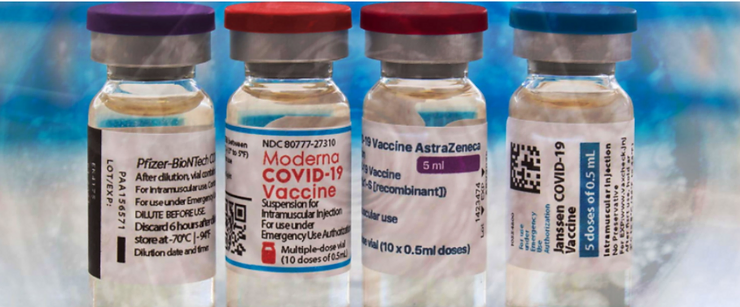


Report 255 | Dr. Robert Young: All Disease is Outfection Not Infection–Vaccine Nano is Bioweapon!

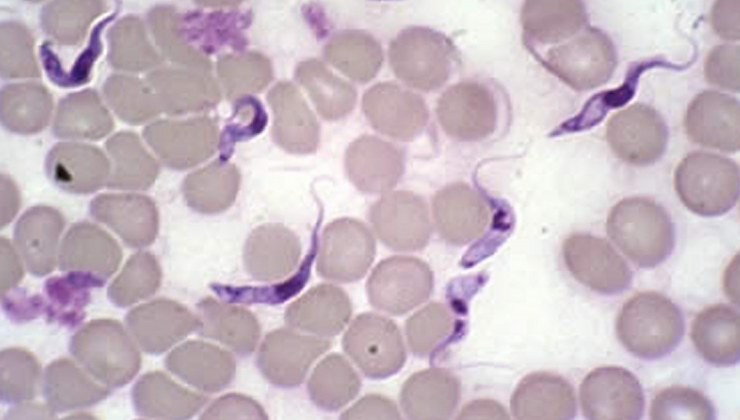

https://www.drrobertyoung.com/post/transmission-electron-microscopy-reveals-graphene-oxide-in-cov-19-vaccines
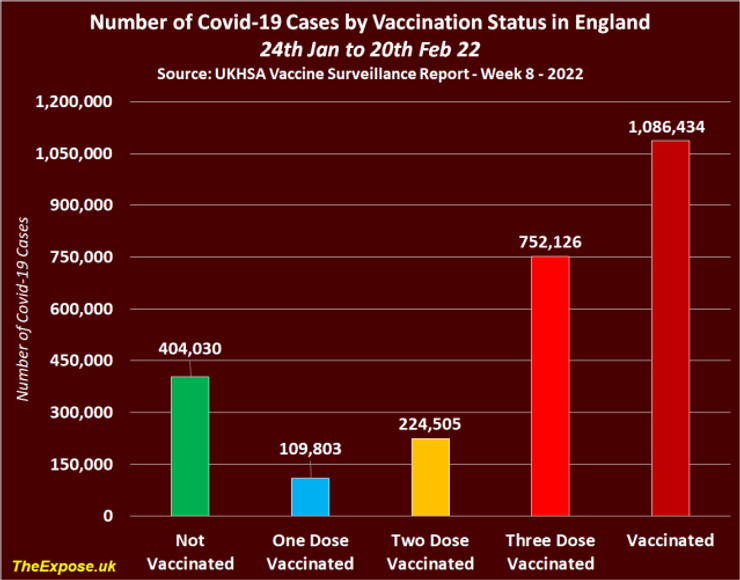
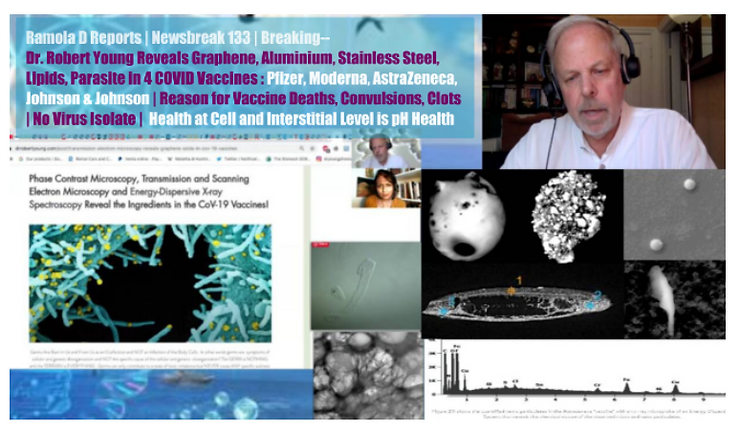
Newsbreak 135–BREAKING: Immense Harm from Crystallizing Blood Cells/Graphene Poisoning Post-Vaccine
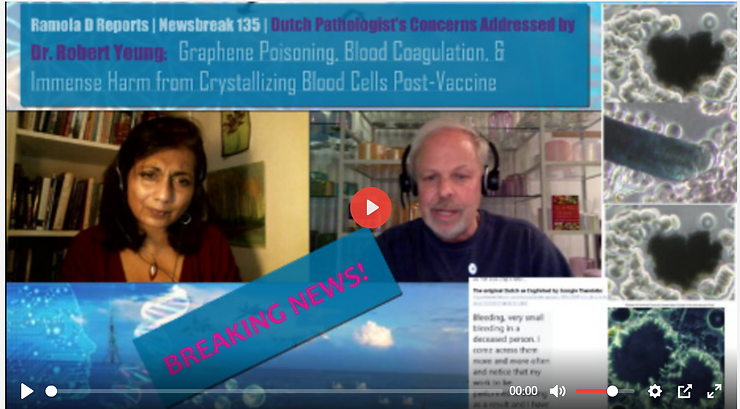
Ramola D Reports | Newsbreak 134 | Dr. Robert Young Calls for Halt on Vaccines, Reveals New Findings
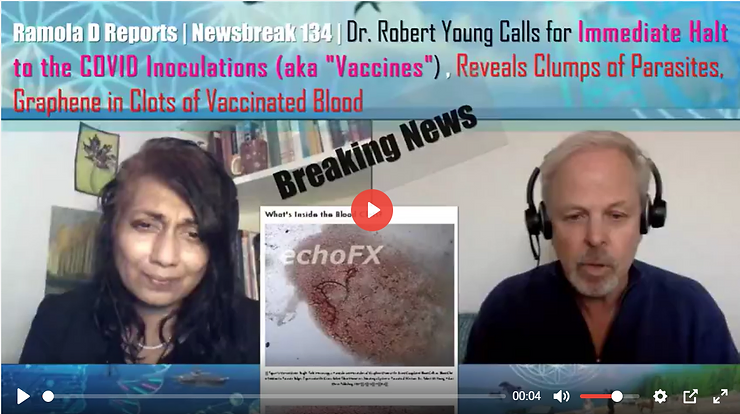
188) Panel 1 – Carnicom Disclosure Project Update 2021, TMT & RDR | Dr. Madej, Dr. Mikovits, Dr. Young

190) Newsbreak 142 | BREAKING: Dr. Young Reveals COVID Vaccines are Intelligent Targeting Bioweapons


Report 279: Panel on Terrain: Hidden Science: Greater Cause of Disease Not Germs but Terrain

Report 275 | Inger & Tea Hartelius with Dr. Young Reveal pH Miracle Lifestyle Healing Cancer & COVID

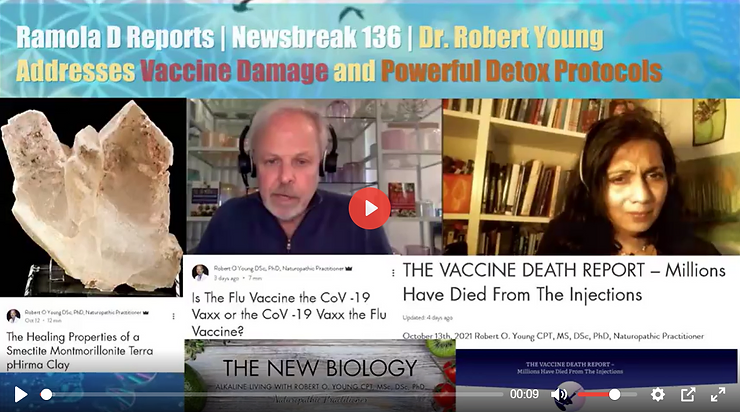

Support Dr. Young here – https://givesendgo.com/G2Z76
“A generous person will prosper; whoever refreshes others will be refreshed.” Proverbs 11:25
Scientific Articles – www.drrobertyoung.com/blog

RAMOLA D REPORTS: DETOX NANOTECH and CLEANSE YOUR PINEAL GLAND Try Clean Slate, Zero-In, and Restore for detox and daily health at this link (which supports this channel): https://therootbrands.com/micmar
FIND PRINT/VIDEO CONTENT:
Media Site and Magazine: everydayconcerned.netAuthor website: ramolad.com
Ramola D Reports is at: Bitchute, Brighteon, Odysee, Live 528, Rumble
SUBSCRIBE Monthly, PLEASE SUPPORT MY TRUE-MEDIA WORK
Patreon: Patreon.com/RamolaD. Paypal: Paypal.me/RamolaD



